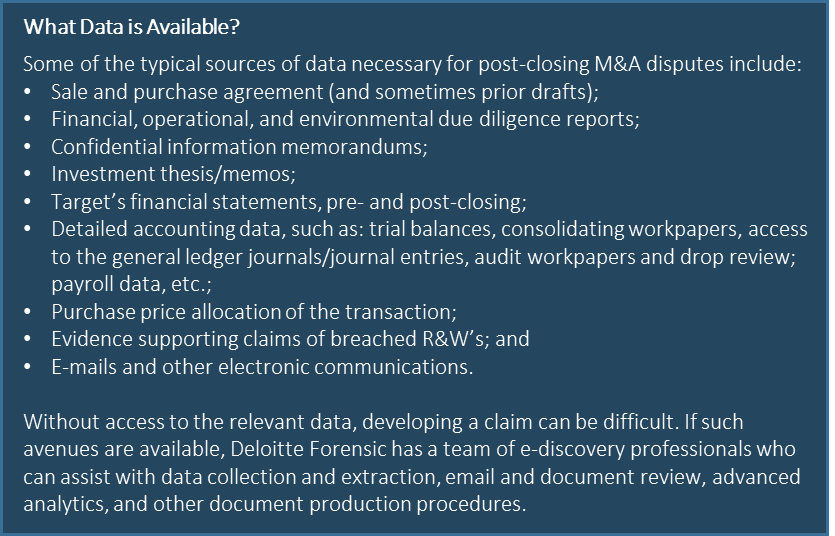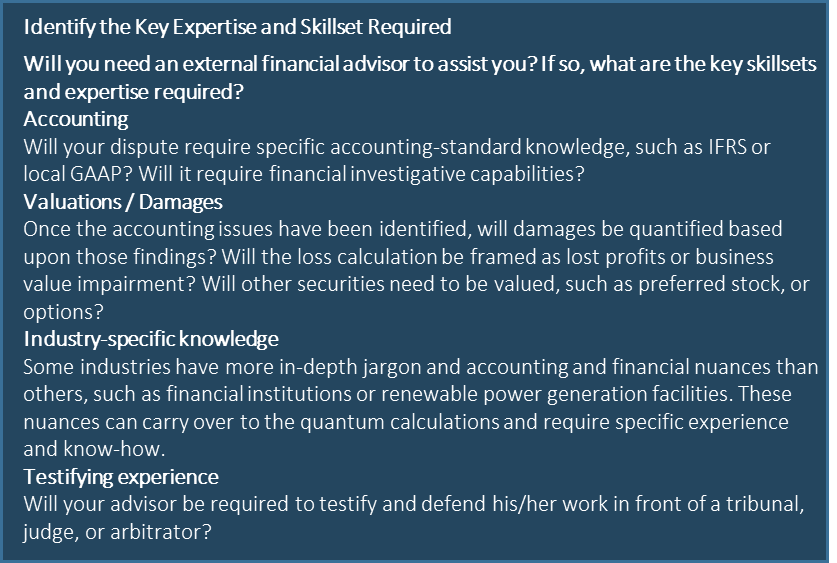Insight

Post-Closing M&A Disputes
Within our Deloitte Forensic services, we assist both buyers and sellers through the post-closing stages of deals and provide services in an M&A context to determine matters in M&A-related disputes, for arbitration and insurance cases.
In the M&A life cycle both buyers and sellers can spend substantial effort and resources in drafting a sale and purchase agreement (“SPA”) and performing the relevant due diligence to decrease the post-closing risk exposure. Once a M&A deal has closed, the most common types of Post-Closing M&A disputes arise in relation to:
- Breach of Representations and Warranties
- Contingent Payment; and
- Closing Accounts
Breach of Representations and Warranties
The Representations and Warranties (R&W’s) embedded within an SPA provide disclosures, and thus risk protection, to both the buyer and the seller. Representations are statements of past and/or existing facts surrounding the target, while warranties are promises that existing and/or future facts are, or will be, true. One of the more routine sellers’ R&W’s might illustratively read as follows:
“The target’s historical financial statements over the past fiscal years, provided to the buyer, were prepared in accordance with the LOCAL GAAP, and the target’s books and records are fairly stated in all material respects, and all known material liabilities have been disclosed.”
After closing, the buyer, with the rights of control and ownership of the target, along with full access to its books and records, may discover one (or more) of the seller’s R&W’s to be untrue. If this proves to be the case, the buyer may need to i) fully assess whether the seller’s R&W’s were in fact breached, ii) whether damages were incurred by the buyer due to the breach, and iii) if the SPA stipulates whether such damages are indemnifiable by the seller to the buyer or, perhaps, indemnity is covered by a Warranty and Indemnity (W&I) insurance policy.
Such situations can be more complex as the buyer may have to determine whether the R&W’s were presented fraudulently, or merely drafted poorly, and assess which indemnity provisions in the SPA are relevant. Recourse to legal counsel should be considered.
“...the buyer may need to i) fully assess whether the seller’s R&W’s were in fact breached, ii) whether damages were incurred by the buyer due to the breach, and iii) if the SPA stipulates whether such damages are indemnifiable by the seller...“
Calculating damages due to the breach usually requires the assistance of forensic professionals who are experienced in using the accepted methodologies, taking the prevailing facts and circumstances into proper consideration of the facts and circumstances. For example, if the breached R&W leads to a permanent impairment of the target’s value, a damages assessment may be more akin to a business valuation than a lost profits analysis.
Once damages have been assessed, the SPA’s indemnity limitations, if any, must be taken into consideration as well.
Contingent Payments
Contingent payment, or ‘earn-out’, clauses can be part of the transaction consideration structure to compensate the seller based on the future performance of the target. Contingent payments are commonplace as they are utilized as a manner to i) bridge differences between the buyer’s and seller’s outlook of the target’s expected financial performance, and/or ii) create financial incentives for the target’s post-closing management team.
Such deal terms are referred to as “contingent payments” because the amount of the payment depends on the future performance of the target, which, as any executive knows, is subject to risks and uncertainties.
Common types of continent payments include:
- Additional compensation to the sellers: typically, based on the future performance of the target, over a specific time-period (e.g., two years post-closing), using financial metrics such as: revenues, gross profits, EBITDA, operating profit, or net income, etc.
- Escrowed funds: a portion of the deal consideration is placed in an escrow account, to be released to the seller if and when the target reaches certain milestones. If such stipulations are not met, then the funds are returned to the buyer
However, in our experience, contingent payments can lead to disputes arising between the parties post-closing.
In the first place, differences in the interpretation of the relevant portions of the SPA is the likely starting ground for disputes. Next, changes/corrections to the target’s accounting policies can also lead to areas of disagreement. Lastly, and perhaps the most difficult to assess, changes in the direction and management of the target post-closing, which impact the contingent payment, can spawn heated disputes between the parties.
Such complexities inherent in contingent payments require trust between the parties while drafting the terms of the SPA as unforeseen circumstances and unintended consequences may come to light post-closing (e.g., economic impacts from geo-political situations).
“...differences of interpretation of the relevant portions of the SPA is the likely starting ground for disputes.“
Closing Accounts
It is common for acquisitions of privately-held businesses to incorporate a purchase price adjustment following the deal closing to account for the target’s changes in net debt and working capital. Conceptually, these purchase price adjustments are made to compensate the parties for changes in the target’s balance sheet between the i) transaction closing date; and ii) the SPA-defined balance (simply referred to as a ‘peg’).
To calculate such an adjustment, the SPA typically requires the buyer to prepare and submit to the sellers, within a certain time limit post-closing, the target’s balance sheet as of the closing date. Frequently, the SPA will require that the closing balance sheet be prepared in compliance with an accounting ‘hierarchy’. For example, the completion accounts might firstly be required to follow specific accounting policies for certain balances, then be prepared in accordance with a defined accounting-standard (e.g., the local generally-accepted accounting principles “GAAP”), and lastly, prepared in a consistent manner with the target’s prior accounting policies. These seemingly simple requirements can create disagreements between the parties. For example, the buyer may correct previously unidentified errors from the target’s prior accounting policies.



Team of experienced experts
The Deloitte Forensic practice has professionals with deep experience assisting parties through all types of post-closing M&A disputes. We are able to assist either party individually develop their stance acting in an advisory role, serve both sides as neutral financial and accounting experts, or act as independent experts to offer an opinion before a judge/tribunal. With a team of experienced professionals dedicated to dispute resolution engagements, supported by our Deloitte network (encompassing transaction services professionals, industry experts, and accounting experts across the globe), we can meet your needs to resolve post-closing M&A dispute matters.

